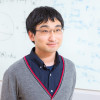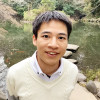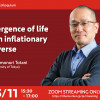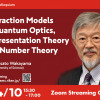115 events in 2020
-
Lecture

iTHEMS Intensive Course [1] : "Adaptive strategies of organisms, their mathematical bases" - Sex expression and sex allocation of marine organisms
June 18 (Thu) at 13:30 - 15:00, 2020
Yoh Iwasa (Senior Advisor, RIKEN Interdisciplinary Theoretical and Mathematical Sciences Program (iTHEMS) / Professor, Kwansei Gakuin University / Professor Emeritus, Kyushu University)
Living systems exhibit features distinct from nonliving physical systems: their structure and behaviors appear to be chosen adaptive. They are the outcomes of evolution. Mathematical formalisms developed in engineering and social sciences (e.g. control theory, game theory, evolutionary game theory) are sometimes very useful in biology.
Venue: via Zoom
Event Official Language: English
-
Seminar
Information geometry of operator scaling
June 17 (Wed) at 16:00 - 18:10, 2020
Tasuku Soma (Research Associate, Graduate School of Information Science and Technology, The University of Tokyo)
Matrix scaling is a classical problem with a wide range of applications. It is known that the Sinkhorn algorithm for matrix scaling is interpreted as alternating e-projections from the viewpoint of classical information geometry. Recently, a generalization of matrix scaling to completely positive maps called operator scaling has been found to appear in various fields of mathematics and computer science, and the Sinkhorn algorithm has been extended to operator scaling. In this study, the operator Sinkhorn algorithm is studied from the viewpoint of quantum information geometry through the Choi representation of completely positive maps. The operator Sinkhorn algorithm is shown to coincide with alternating e-projections with respect to the symmetric logarithmic derivative metric, which is a Riemannian metric on the space of quantum states relevant to quantum estimation theory. This talk is based on joint work with Takeru Matsuda.
Venue: via Zoom
Event Official Language: English
-
Seminar

Field theoretical approach to relativistic hydrodynamics
June 12 (Fri) at 13:00 - 14:30, 2020
Masaru Hongo (Visiting Scientist, RIKEN Interdisciplinary Theoretical and Mathematical Sciences Program (iTHEMS) / Postdoctoral Research Associate, Physics Department, The University of Illinois at Chicago (UIC), USA)
Hydrodynamics is a low-energy effective theory of a conserved charge density, which describes a long-distance and long-time behavior of many-body systems. It is applicable not only to a non-relativistic weakly-interacting dilute gas but also a relativistic strongly-interacting dense liquid like a quark-gluon plasma. The main purpose of this seminar is to explain how we can derive the hydrodynamic equation from the underlying field-theoretical description of systems [1-3]. Our derivation is based on the recent development of non-equilibrium statistical mechanics, and we show that the procedure to derive hydrodynamic equations is similar to the so-called renormalized/optimized perturbation theory. Also, to describe transport phenomena in local thermal equilibrium, we give a path-integral formula for a thermodynamic functional, which results in the emergence of thermally induced curved spacetime [2]. These results enable us to derive hydrodynamic equation based on quantum field theories.
Event Official Language: English
-
Seminar
The effect of the early kinetic decoupling in a fermionic dark matter model
June 12 (Fri) at 10:00 - 11:00, 2020
Tomohiro Abe (Assistant Professor, Kobayashi-Maskawa Institute for the Origin of Particles and the Universe (KMI), Nagoya University)
*Detailed information about the seminar refer to the email
Venue: via Zoom
Event Official Language: English
-
Seminar

Turing Patterns in Biology and Beyond
June 10 (Wed) at 10:00 - 10:45, 2020
Martin Skrodzki (Visiting Scientist, RIKEN Interdisciplinary Theoretical and Mathematical Sciences Program (iTHEMS) / Fellow, German Academic Scholarship Foundation, Germany)
In his 1952 paper "The chemical basis of morphogenesis", Alan M. Turing presented a model for the formation of skin patterns. While it took several decades, the model has been validated, e.g. in the skin pattern formation of zebrafish. More surprising, seemingly unrelated pattern formations can also be studied via the model, like e.g. the formation of plant patches around termite hills. In 1984, David A. Young proposed a discretization of Turing's model, reducing it to a activator/inhibitor process on a discrete domain. In my talk, I will present both the model of Turing and its discretization. We will then consider a generalization to pattern-formation in three-dimensional space and investigate the related parameter space.
Venue: via Zoom
Event Official Language: English
-
Seminar

Quantification model of energy of loop structure on biopolymer
June 3 (Wed) at 10:00 - 10:45, 2020
Hiroshi Yokota (Postdoctoral Researcher, RIKEN Interdisciplinary Theoretical and Mathematical Sciences Program (iTHEMS))
During cell division, the chromatin fiber condenses into a rod-like shape, which is the so-called chromosome. The chromosome is constructed by consecutive chromatin loop structures whose excluded volume interaction gives chromosome its stiffness. So far, the energy source for the loop growing has remained a controversial issue. In this seminar, we quantify the energy source by calculating the free energy difference before and after a model polymer chain creating a loop structure.
Venue: via Zoom
Event Official Language: English
-
Seminar

Localization and universality in non-Hermitian many-body systems
May 29 (Fri) at 15:00 - 16:30, 2020
Ryusuke Hamazaki (Senior Research Scientist, RIKEN Interdisciplinary Theoretical and Mathematical Sciences Program (iTHEMS) / RIKEN Hakubi Team Leader, Nonequilibrium Quantum Statistical Mechanics RIKEN Hakubi Research Team, RIKEN Cluster for Pioneering Research (CPR))
Recent study on isolated quantum many-body systems have revealed two different phases distinguished by their dynamics and spectral statistics. One is an ergodic phase whose spectral statistics exhibit universality of random matrices, and the other is a many-body localized phase where dynamics is constrained due to strong disorder. In this talk, we show that novel and rich physics concerning such localization and universality appears in non-Hermitian many-body systems, which have been utilized in diverse scientific disciplines from open quantum systems to biology. As a first topic, we analyze non-Hermitian quantum many-body systems in the presence of interaction and disorder [1]. We demonstrate that a novel real-complex transition occurs upon many-body localization of non-Hermitian interacting systems with asymmetric hopping that respect time-reversal symmetry. As a second topic, we show that “Dyson’s threefold way,” a threefold symmetry classification of universal spectral statistics of random matrices, is nontrivially extended to non-Hermitian random matrices [2]. We report our discovery of two distinct universality classes characterized by transposition symmetry, which is distinct from time-reversal symmetry due to non-Hermiticity. We show that the newly found universality classes indeed manifest themselves in dissipative quantum many-body ergodic systems described by Lindblad equations.
Venue: via Zoom
Event Official Language: English
-
Seminar

Knotted 2-spheres in the 4-space and Yang-Mills gauge theory
May 27 (Wed) at 16:00 - 18:10, 2020
Masaki Taniguchi (Special Postdoctoral Researcher, RIKEN Interdisciplinary Theoretical and Mathematical Sciences Program (iTHEMS))
The classification problem of knots is one of the central topics in a study of topology. In the first part, we review classical knot theory and theory of 2-dimensional knots in the 4-dimensional space. In the second part, we focus on a problem considered in differential topology. In the studies of differential topology, people are interested in the difference between continuous and smooth. As the main result of this talk, we introduce a theorem that tells us the difference between continuous and smooth 2-dimensional knots. The proof uses Yang-Mills gauge theory for 4-manifolds obtained by the surgery of 2-knots.
Venue: via Zoom
Event Official Language: English
-
Seminar
Forgetting in Reinforcement Learning Links Sustained Dopamine Signals to Motivation
May 27 (Wed) at 10:00 - 10:45, 2020
Ayaka Kato (RIKEN Center for Brain Science (CBS) / Ph.D. Student, The University of Tokyo)
Dopamine (DA) has been suggested to have two reward-related roles: (1) representing reward-prediction-error (RPE), and (2) providing motivational drive. Role(1) is based on the physiological results that DA responds to unpredicted but not predicted reward, whereas role(2) is supported by the pharmacological results that blockade of DA signaling causes motivational impairments such as slowdown of self-paced behavior. Whereas synaptic/circuit mechanisms for role(1), i.e., how RPE is calculated in the upstream of DA neurons and how RPE-dependent update of learned-values occurs through DA-dependent synaptic plasticity, have now become clarified, mechanisms for role(2) remain unclear. We modeled self-paced behavior by a series of ‘Go’ or ‘No-Go’ selections in the framework of reinforcement-learning assuming DA's role(1), and demonstrated that incorporation of decay/forgetting of learned-values, which is presumably implemented as decay of synaptic strengths storing learned-values, provides a potential unified mechanistic account for the DA's two roles, together with its various temporal patterns.
Venue: via Zoom
Event Official Language: English
-
Seminar

Gradient Flow Equation and Its Applications
May 15 (Fri) at 13:30 - 15:00, 2020
Kengo Kikuchi (Special Postdoctoral Researcher, RIKEN Interdisciplinary Theoretical and Mathematical Sciences Program (iTHEMS))
Gradient flow is the one of the methods to suppress the ultraviolet divergence in gauge theories. The any correlation functions in terms of the flowed field, which is defined by the gradient flow equation, are finite without additional renormalizations. Because of this surprising property, the methods has been studied widely, especially in the lattice field theory. In this seminar, we introduce what the gradient flow is briefly. And we show our work, “generalized gradient flow equation”, which is the gradient flow equation for field theories with nonlinearly realized symmetry. Applying the formalism to a supersymmetric theory and O(N) non linear sigma model, we obtain the SUSY gradient flow and the Large N gradient flow. We also refer to the current research, the gradient flow of the supersymmetric theory with the non-renormalization theorem and the new formalism to obtain the sphalerons, which is one of the static classical solutions, using gradient flow methods, if time allows.
Venue: via Zoom
Event Official Language: English
-
Seminar

How many electrons can atoms bind?
May 13 (Wed) at 16:00 - 18:10, 2020
Yukimi Goto (Special Postdoctoral Researcher, RIKEN Interdisciplinary Theoretical and Mathematical Sciences Program (iTHEMS))
In this talk, I will introduce the mathematical studies on the ionization problem. Some experimental & numerical evidences say that any doubly charged atomic ion X^{2-} is not stable. This 'fact' is called the ionization conjecture in mathematical physics literatures. My hope is to illustrates the interplay between mathematical and physical ideas. The talk is directed towards researchers on various aspects of quantum mechanics. In the first part, we will discuss the many-body aspects of quantum mechanics and introduce some basic notions. The second part will deal with the mathematical results in some approximation theories.
Venue: via Zoom
Event Official Language: English
-
Seminar

Models to describe how virus spreads in vitro
May 13 (Wed) at 10:00 - 10:45, 2020
Catherine Beauchemin (Senior Visiting Scientist, RIKEN Interdisciplinary Theoretical and Mathematical Sciences Program (iTHEMS) / Professor, Department of Physics, Ryerson University, Canada)
This is meant as an introductory talk about my research field, virophysics, in which I apply the rigour and methods of physics to study virology. My focus is primarily in vitro (how virus spreads cell-to-cell in a cell culture) but I occasionally do some in vivo work. Recently, my hobby became tracking COVID-19 spread.
Venue: via Zoom
Event Official Language: English
-
Colloquium

Emergence of life in an inflationary universe
May 11 (Mon) at 15:30 - 17:00, 2020
Tomonori Totani (Professor, Department of Astronomy, Graduate School of Science, The University of Tokyo)
The origin of life may be the greatest mystery in natural science. Especially, we know almost nothing about how the first biological molecule (possibly an RNA) appeared from abiotic chemical processes. A widespread notion is that the abiogenesis probability is extremely low when we consider only random chemical reactions to polymerize a large biological molecule. However, we do not know any more efficient polymerization process expected to work in a realistic prebiotic environment. Here, I consider this problem from a viewpoint of cosmology. Cosmologists agree that the universe created by an inflation should extend far beyond the observable universe (13.8 billion light year radius). Then the inflationary universe may be sufficiently large to produce many abiogenesis events, even if we consider only the basic random polymerization. I will give a quantitative answer to this question, and discuss various implications about the origin-of-life studies.
Venue: via Zoom
Event Official Language: English
-
Seminar
Slip or (k)not: Geometry and mechanical performance of physical knots
May 7 (Thu) at 17:00 - 17:45, 2020
Tomohiko Sano (PD, École polytechnique fédérale de Lausanne, Switzerland)
Knots can impart unique mechanical function to filamentary structures, with examples ranging across length scales, including DNA, polymer-chains, shoelaces, climbing ropes, tennis racket, and surgical sutures. Even though knot theory has a long history of studies in the realm of mathematics, mechanics-based studies of physical knots are much rarer. The fundamental challenge in the understanding of their mechanics under a wide range of loading conditions stems from the fact that their topology, geometry, elasticity, and friction are all tangled ingredients. In this talk, combining experiments, simulations and theory, we present the recent progress on the predictive framework for the knot performance.
Venue: via Zoom
Event Official Language: English
-
Seminar

From Eigenvalues to Resonances
May 1 (Fri) at 16:00 - 18:10, 2020
Keita Mikami (Research Scientist, RIKEN Interdisciplinary Theoretical and Mathematical Sciences Program (iTHEMS))
Resonance is one of the most studied object in mathematical study of Schrödinger operators. One possible reason is that resonance is appeared in many other fields like arithmetic, physics, and topography. This series of talks target both mathematicians and researchers in other fields. The goal of the talk is to introduce the study of resonances for two body Schrödinger operators. In the first part, we briefly review spectral theory and how we use it in the study of Schrödinger operators. The aim of this part is to introduce the audience some basic notions used in the study of Schrödinger operators. In the second part, we give brief introduction of resonances and its application to both mathematicians and researchers in other fields. We start from mathematical definition of resonances to its applications in the other fields.
Venue: via zoom
Event Official Language: English
-
Seminar

Analyses of large-scale sequence data from “PROTIST” can reveal the eukaryotic phylogeny and evolution
April 30 (Thu) at 10:00 - 10:45, 2020
Euki Yazaki (Postdoctoral Researcher, RIKEN Interdisciplinary Theoretical and Mathematical Sciences Program (iTHEMS))
Most of the phylogenetic diversity of eukaryotes is made up of unicellular eukaryotic microorganisms called protists, some of which have not known phylogenetic home (called Orphans). Orphans are likely to hold important keys to the evolution of eukaryotes. In this seminar, I will introduce present case studies that reveal phylogenetic home and organelle evolution of orphan protists through sequence analysis based on large-scale sequence data.
Venue: via Zoom
Event Official Language: English
-
Seminar
Characterizing the continuous gravitational-wave signal from boson clouds around Galactic isolated black holes
April 27 (Mon) at 16:00 - 17:00, 2020
Sylvia Zhu (Postdoctoral Researcher, Deutsches Elektronen-Synchrotron DESY, Germany)
Bosons such as axions or axion-like particles can form enormous clouds around black holes via the superradiance instability. As the bosons annihilate in the presence of the black hole, they produce a long-lived, slowly-evolving continuous gravitational-wave signal that is potentially detectable using the current generation of gravitational-wave interferometers.A non-detection can disfavor the existence of axions in certain mass ranges, although this is highly dependent on the Galactic black hole population. In this talk, I will discuss the expected annihilation signal from the population of isolated stellar-mass black holes in the Galaxy, and the prospects for detecting the signal using standard searches for continuous gravitational waves.
Venue: via Zoom
Event Official Language: English
-
Seminar
Social evolution in viruses
April 22 (Wed) at 10:00 - 10:45, 2020
Asher Leeks (International Program Associate, RIKEN Interdisciplinary Theoretical and Mathematical Sciences Program (iTHEMS) / Ph.D. Student, Department of Zoology, University of Oxford, UK)
Viruses are normally thought of as solitary organisms. However, in reality viruses often interact with one another, and these interactions can have important consequences for how viruses evolve and cause disease. In this talk, I will show how simple models of virus-virus interactions can help us to understand some puzzling aspects of virus biology. At the end, I will also talk about a new modelling project on Covid-19 joint with Ryosuke, which considers how human actions such as social distancing could influence the evolution of virulence.
Venue: via Zoom
Event Official Language: English
-
Special Lecture

iTHEMS x academist Online open to the public "World of Mathematical Sciences"
April 18 (Sat) at 10:00 - 17:00, 2020
Yuki Yokokura (Senior Research Scientist, RIKEN Interdisciplinary Theoretical and Mathematical Sciences Program (iTHEMS))
Ryosuke Iritani (Research Scientist, RIKEN Interdisciplinary Theoretical and Mathematical Sciences Program (iTHEMS))
Hirotaka Irie (Visiting Scientist, RIKEN Interdisciplinary Theoretical and Mathematical Sciences Program (iTHEMS) / Assistant Manager, DENSO Corporation)
Nagisa Hiroshima (Visiting Scientist, RIKEN Interdisciplinary Theoretical and Mathematical Sciences Program (iTHEMS) / Assistant Professor, Department of Physics, Faculty of Science, University of Toyama)
Hiroyasu Miyazaki (Special Postdoctoral Researcher, RIKEN Interdisciplinary Theoretical and Mathematical Sciences Program (iTHEMS))
Akinori Tanaka (Senior Research Scientist, RIKEN Interdisciplinary Theoretical and Mathematical Sciences Program (iTHEMS))Venue: via Zoom
Event Official Language: Japanese
-
Colloquium

Interaction Models in Quantum Optics, Representation Theory and Number Theory
April 10 (Fri) at 15:30 - 17:00, 2020
Masato Wakayama (Senior Advisor, RIKEN Interdisciplinary Theoretical and Mathematical Sciences Program (iTHEMS) / Vice President, Tokyo University of Science)
Recently, interaction models originated in quantum optics, with the quantum Rabi model (QRM) as a distinguished representative, are appearing ubiquitously in various quantum systems including cavity and circuit quantum electrodynamics, quantum dots and artificial atoms, with potential applications to quantum information technologies such as quantum computing. Together with the integrability of QRM, demonstrated by Daniel Braak in 2011, this has led to wide discussion and development of various aspect of the QRM and its generalizations from the point of view of theoretical physics and mathematics. In this talk, firstly, we characterize the structure of the spectra of QRM and its asymmetric version via sℓ2-representations. Secondly, we introduce the non-commutative harmonic oscillator, which may be considered to be a “cover” of the QRM in the Heun ODE picture, and describe certain number theoretical aspects arising from its spectral zeta function. Further, we discuss the heat kernel and partition function of the QRM toward the number theoretical investigation of the model. In addition, a number of related open problems will be presented.
Venue: via Zoom
Event Official Language: English
115 events in 2020
Events
Categories
series
- iTHEMS Colloquium
- MACS Colloquium
- iTHEMS Seminar
- iTHEMS Math Seminar
- DMWG Seminar
- iTHEMS Biology Seminar
- iTHEMS Theoretical Physics Seminar
- Information Theory SG Seminar
- Quantum Matter Seminar
- ABBL-iTHEMS Joint Astro Seminar
- Math-Phys Seminar
- Quantum Gravity Gatherings
- RIKEN Quantum Seminar
- Quantum Computation SG Seminar
- Asymptotics in Astrophysics SG Seminar
- GW-EOS WG Seminar
- DEEP-IN Seminar
- NEW WG Seminar
- Lab-Theory Standing Talks
- QFT-core Seminar
- STAMP Seminar
- QuCoIn Seminar
- Number Theory Seminar
- Academic-Industrial Innovation Lecture
- Berkeley-iTHEMS Seminar
- iTHEMS-RNC Meson Science Lab. Joint Seminar
- RIKEN Quantum Lecture
- Theory of Operator Algebras
- iTHEMS Intensive Course-Evolution of Cooperation
- Introduction to Public-Key Cryptography
- Knot Theory
- iTHES Theoretical Science Colloquium
- SUURI-COOL Seminar
- iTHES Seminar
